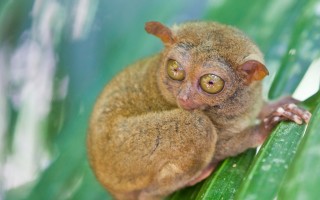Like the monkey it has a flattened face, round skull, erect posture, and haemochrial placenta (where fetal and maternal blood are in conact via capillaries). In shape and size, its ears resemble a bat’s. Unique to the animal, however, are its eyes, which are almost twice as large as those of humans but incapable of seeing from the corners; and its head, which can rotate up to 180 degrees, enabling it to leap backward with high precision. Moreover, with the help of adhesive discs on the soles of its fore and hind limbs, the tarsier clings to branches either vertically or horizontally.
A nocturnal creature, the tarsier normally sleeps during the day and wakes up at sundown. Like the tree shrew and the slow loris, it has low basal rate and temperature and an insectivorous diet. It feeds on crickets, beetles, termites and other insects as well as on vertebrates lizards, small fishes, young birds, frogs and mice crabs, ingesting them live. The tarsier locates its prey visually, aided by its heightened sense of hearing, but probably for protection keeps its eyes closed until the of the prey is inside its mouth. Ten to 12 grams of food are thus consumed in a single day, double that amount by a pregnant female.
The tarsier has been observed to produce a strong smell during the breeding season, which begins in April or May. This is believed to crucial for socialization and sexual communication. Estrus occurs at 24-day intervals, during which courtship and copulation take place. The female gives birth to inly one young after six months, though she may sometimes act as surrogate mother to offspring not her own. A new-born tarsier can already cling to branches; less than a month after birth, the young start leaping; in two months or so, it is weaned from its mother.
The Philippine tarsier is extremely shy and nervous; despite its cuddly looks and proportions, it does not like to be touched,. Those taken in captivity seldom survive or reach full maturity. Fifty years of attempts to breed the specie under controlled conditions locally and abroad have thus far met with very little success. Yet unenlightened foreign tourists and collectors have persisted in smuggling them home as pets.
On Bohol in the Central Visayas region with which the Philippine tarsier has most closely identified, only several hundred of the specie remain. After many years of environmental neglect and ignorance as to its importance for the island’s ecosystem and the country’s biodiversity, help is finally underway to protect and revive this unique and living treasure.
